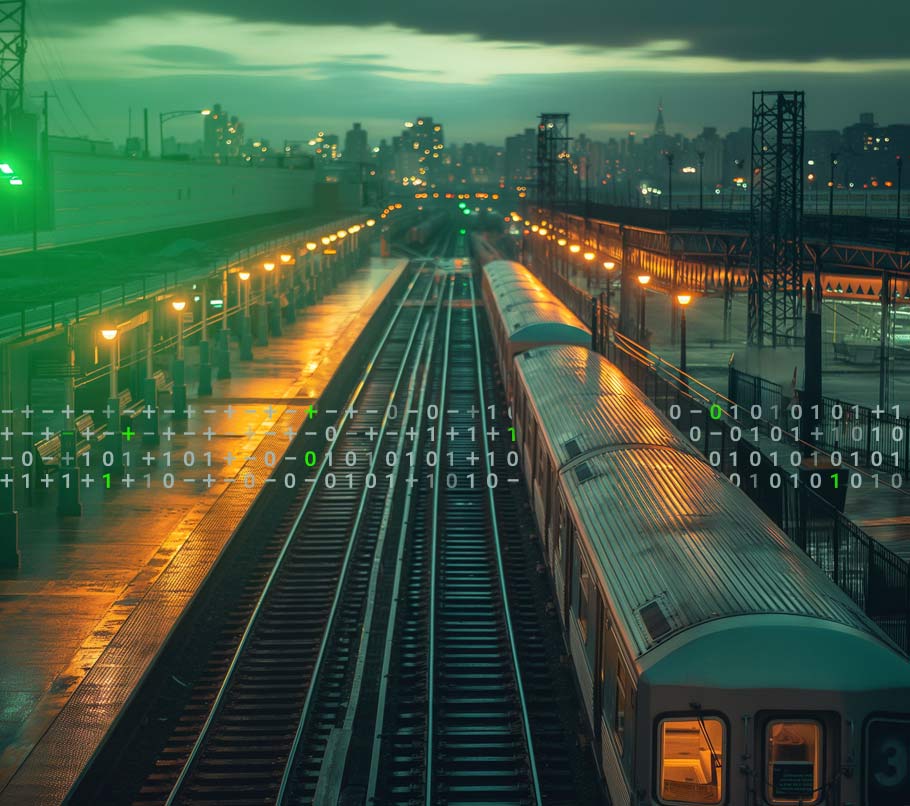Introduction
Groundbreaking power distribution meets mechanical mastery at the newly renovated Long Island Railroad Jamaica Station in Queens, NY. Led by a prominent neutral host provider of high-speed Wi-Fi and cellular services, the project integrated VoltServer™’s Digital Electricity™ platform and Faber Industrial Technologies’ engineering expertise. The result? Unparalleled wireless connectivity for 4G, 5G, and public Wi-Fi across the station’s six island platforms. Download The Case Study
Project Overview
The Facility
Jamaica Station, located in Queens, New York, is one of North America’s busiest rail stations. Its strategic location connects travelers to various destinations across Long Island and Manhattan.
Jamaica Station has the same issues as many public transit terminals, including poor wireless connectivity due to their congested urban spaces, concrete infrastructure, and often underground platforms. Unlike open outdoor environments easily covered by a single macrocell, these environments require small cell densification to overcome signal barriers. Balancing renovation work with uninterrupted commuter flow amidst weekday ridership exceeding 200,000 passengers adds complexity, necessitating innovative solutions and meticulous planning.
The Challenge
The project aimed to upgrade Jamaica Station to accommodate increased commuter capacity by implementing cutting-edge wireless connectivity solutions across its six island platforms. However, traditional power distribution methods were unsuitable for the diverse array of high-powered radios needed throughout the station. Additionally, Meeting MTA specifications for weatherproof, secure, and inconspicuous equipment posed challenges. Installation in a high-traffic area and adapting to scope changes further tested team agility and cross-functional cooperation.
The Solution
The objective was straightforward: To build a communications infrastructure consisting of a variety of SOLID Multi-Power Remote Optic Units and 5G mm-Wave radios throughout the station to ensure connectivity from anywhere. Traditionally, power would need to be branched off from AC mains, distributed, and conditioned according to the load. This is prohibitively expensive and time-consuming when provisioning a large variety of high-powered radios. VoltServer was chosen to deliver the remote power using their Digital Electricity platform. The solution converts analog electricity into Digital Electricity, which can then be distributed using low-voltage wiring practices to receivers that convert the power back to analog AC or DC at the prescribed load voltage.
The station’s six platforms covering thousands of square feet demanded a large network of energized equipment—all of which had to be protected and organized in a safe, consolidated manner. That’s where Faber’s mechanical expertise became invaluable.
The first challenge was to design and fabricate multiple head-end IT racks that could shelve the dozens of VoltServer transmitters required for the project. The custom racks were designed for oversized wire management with room-to-mount lightning protection circuits. The centralized point of power distribution provided the foundation for a universal battery backup so that devices could stay online in the event of a power outage.
At the load ends of the system, the magnitude and scope of the project presented their own hurdles. More than 60 powered devices required dozens of power drop points, and cabinets were needed to house the receivers and cable connections.
The goal was to optimize cabinet space with the strategic arrangement of interior equipment, enabling easy access to each component during service. Faber initially started the design with one of its off-the-shelf enclosures. Still, scope changes—including the addition of Wi-Fi access points throughout the platforms—led to the creation of brand-new enclosures. They each incorporated a subpanel to secure the Digital Electricity receivers, the lightning protection circuits, terminal blocks, and heat exchanger systems while providing easy termination points for the power connections. The design included a second set of hinges near the back so that the entire cabinet could flip outwards, providing rear access to components and connector
Implementation Details
“VoltServer’s equipment powers nearly 60 kW of loads, including tens of PoE switches, MPROUs and 5G radios.”

Implementation Details
Distance Considerations
VoltServer’s equipment powers nearly 60 kW of loads, including PoE switches, 4G, and 5G radios. To get the system up and running, Faber developed testing procedures to verify power going to the PoE switches, AC units, and continuity between the circuit breakers and cable.
Installation and Training
The renovation was a masterclass on two teams adjusting on the fly with modifications to keep up with a project having many moving parts. Despite the technical prowess behind the system, perhaps the project’s biggest achievement was overcoming the nature of the working environment. Jamaica Station is the fourth-busiest rail station in North America, with weekday ridership exceeding 200,000 passengers. There are no “off-hours” available for installation crews to work with limited interference from pedestrians. Faber streamlined the process by building and shipping the fully furnished head-end racks and load-end cabinets with VoltServer’s equipment. With all components prewired and secured, the team had to mount the cabinets, pull in the cable, and terminate it.
Results and Future Expansion
The project’s success lies in its ability to deliver reliable connectivity in a high-traffic environment. With the implementation complete, the system is poised for future expansion and upgrades to meet the station’s evolving needs.
Conclusion
The collaboration between VoltServer and Faber has resulted in a cutting-edge communications infrastructure at Jamaica Station. The project successfully overcame challenges with power distribution and equipment organization by leveraging VoltServer’s Digital Electricity platform and Faber’s mechanical expertise. The result is a network that ensures seamless connectivity for the station’s hundreds of thousands of daily commuters, setting a new standard for mobile densification in public transit hubs.
